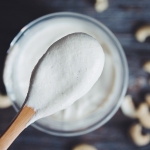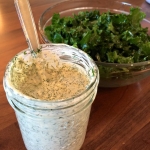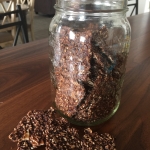Whether you are a new-be or an expert sourdough bread maker, this simple, fail-proof recipe is amazing. I’m going to break it down step-by-step with photos because if you are like me – a visual is all you need to know you are on the right track. The full recipe is posted near the end of this post.
Your end product… a moist, sour, crusty loaf of sourdough bread. Every loaf comes out tasting a little different and no loaf will look the same.
Perhaps that’s part of the reason I enjoy making this so much, there’s no way to mess it up! It still amazes me that you can get such a great tasting treat from three simple ingredients – water, flour and salt. After making this, I’d never go back to making traditional bread. Ok let’s get started. I like to start this process first thing in the morning (or even better in the evening just before going to bed) as it usually takes all day to rise properly.
Before starting, your sourdough starter should look something like this:

To ensure it’s ready for baking, you could do the float test. It’s very simple. Fill a glass up with warm water, then drop about a 1/2 tsp of your starter into your cup of warm water. If it floats, it’s ready to bake with. (Search it on youtube for a visual if you need).
If you’ve been given sourdough starter and don’t know what to do with it, I really enjoyed Cultures for Health post for instructions and a video on what to do. From experience, I’d ensure that you’ve fed your sourdough starter at least 3 times before baking with it.
Ok, now that you have your starter ready, get yourself a large mixing bowl and mix together 1 cup starter, 2 cups warm water and 3 cups of your flour. Once mixed well, it should look like this:

Lightly cover with tea towel. You need to let this mixture sit out anywhere from 2 to 8 hours (or even overnight like I did this time and plan on the next step first thing in the morning). The sponge needs to double in size. I find it’s ready when it’s risen all it can rise and it start collapsing like in the picture below (or as soon as you get up in the morning). The warmer your kitchen, the faster it will rise.

Now the sponge is ready for the rest of the ingredients. Mix 1 cup of flour with 2 1/2 tsp of sea salt. Add this to your sponge and mix well. Keep adding in flour (a little at a time) until your dough is just slightly sticky and hard to mix with your wooden spoon. You may have to use your hands. You are going to need to use your judgement here – as sour dough is typically stickier than normal bread dough. Depending on your sponge and the type of flour you are using, the amount of flour you add can range anywhere from 1 cup to 3 cups.
Transfer dough to a lightly floured surface and knead for about 10 to 20 minutes. This step is very important as it activates the gluten. You can take breaks in between, but ensure you knead it well. As the dough is stickier than regular bread dough, make sure to have flour close by to flour your hands (I’ve even lightly oiled my hands). The stickier you can keep the dough, the lighter your bread will be. Let the dough rest (anywhere from 3 to 10 minutes) as you wash and dry your mixing bowl. Lightly grease your bowl with oil (I used coconut oil).
After it is done resting and your bowl is ready, knead the dough for a couple more minutes. Transferred to greased bowl. Make sure to roll your dough in the grease so the top of your dough isn’t dry and lightly greased. ***If you are wanting to make bread into standard loaves instead of round loaves like here, see notes below at this step.***

Cover the bowl and set in warm spot. Allow to rise for 1-2 hours until it’s doubled in size. (Again, this may take longer depending on the temperature of your kitchen).

Carefully divide the dough into two equal pieces with a sharp knife, ensuring you handle it as little as possible.

Shape into two round loafs and place on lightly greased parchment paper-lined on cookie sheets. (If you don’t have parchment paper you should cause it’s amazing and you’ll never have to clean a cookie sheet again. You could always just use a greased cookie sheet).

You’ll want to cover the loaves as they rise. I grease another piece of parchment paper and lightly lay it on top.
Let the loaves rise in a warm place until they have doubled in size (about 2-4 hours). You can let the loaves rise as long as 12 hours. The longer you let the loaves rise, the more sour they will be. This time, I let them rise about 4 hours.

Don’t move your loaves -even if they are touching. You can easily deflate them. Instead pull them apart after they have baked, it will be much easier. Heat your oven to 400 degrees F. Just before your loaves go into the pre-heated oven, gently slash the tops of them like this (or however you want really, this is your bread so get creative!)…
Bake until golden brown (15-35 minutes depending on the size of your loaves).

Now this is the hardest part… wait until they’ve completely cooled until you slice the bread. (I know this is hard and there was a couple times where we couldn’t wait and had to eat it immediately. It does taste good fresh out of the oven, but it tastes even better after it’s cooled.)
After loaves have completely cooled, store in air tight bag or container on the counter. Bread can easily be frozen as well. Enjoy!!
*** To make standard sandwich bread loaves, follow these instructions after you’ve kneaded your dough***
Once you’ve finished kneading your dough, instead of moving your dough to your greased bowl, cut the dough into two equal pieces. Shape into long logs that will fit into two greased bread pans. Gently set in bread pans, flipping once to ensure the top of your loaves are nicely oiled. Cover with a tea towel in a warm location and let rise 3-8 hours (depending on how warm your kitchen is and how big you’d like your loaves). Transfer to preheated oven (400 degrees F). Bake until golden brown. Cool in pans for 10 minutes and then transfer to wired racks to cool. If you are planning on freezing this bread, I’d suggest slicing it ahead of time so you are able to grab slices from the freezer as you need it.
Basic Sourdough Bread
Ingredients:
- 1 cup sourdough starter
- 3 cups flour of choice (white, einkorn, whole wheat)
- 2 cups water (warm)
- 1 to 3 cups flour of choice
- 2 1/2 tsp sea salt
- 1-2 tbsp oil for greasing (I prefer coconut oil)
Directions:
Pour 1 cup of starter into a large glass or plastic mixing bowl. Add in 3 cups of flour and 2 cups of warm water. Mix vigorously with a wooden spoon. Cover with tea towel, plastic lid, or plastic wrap (just make sure it’s not completely sealed), place on the counter in your kitchen and allow to rise for 2 to 8 hours (or even overnight) until its doubled in size. The longer it’s left to rise, the more sour your bread will be.
After this has doubled in size (or first thing in the morning if you’ve let it rise overnight) remove the cover. In a separarte bowl, combine one cup of flour and the sea salt. Add this mixture to your dough and mix well. Slowly add in more flour, little by little, until your dough comes together and is hard to stir with your wooden spoon (make sure to keep your dough on the stickier side, as it will result in fluffier bread).
Turn the dough onto a lightly floured surface and knead for about 10 to 15 minutes (you can take breaks if you wish). Add additional flour as needed only to keep it from sticking. Give the dough a rest while you clean out your mixing bowl. Ensure to dry it well and then lightly grease it with the oil of your choice (I used coconut oil). Go back to your dough and knead for an additional 5 minutes. ***If you are wanting to make bread into standard loaves instead of round loaves like here, see notes above at this step.
Place the dough in greased bowl, flipping it once to ensure the top of your dough is greased. Cover and let rise another 1-2 hours until it’s doubled in size.
Once it’s doubled in size, take a sharp knife and carefully cut the dough into two parts – ensuring that they are very close the same size. Shape dough into nice oval loaves and set on greased cookie sheet (allowing room for each loaf to expand). Cover and allow to rise until they doubled in size (anywhere from 2 hours to as long as 14 hours if you wish)
When they are ready to bake, preheat oven to 400 degrees F. Remove the cover, slash the tops in the design of your choice and bake for 15-30 minutes until golden brown and sound hallow (ensure not to under bake or over bake your bread). Remove loaves to a cooling rack. Allow to completely cool before slicing (if you have the will power… haha!)
Store in airtight container on the counter or package up for freezing.
Recipe Adapted from pinchmysalt.com


















